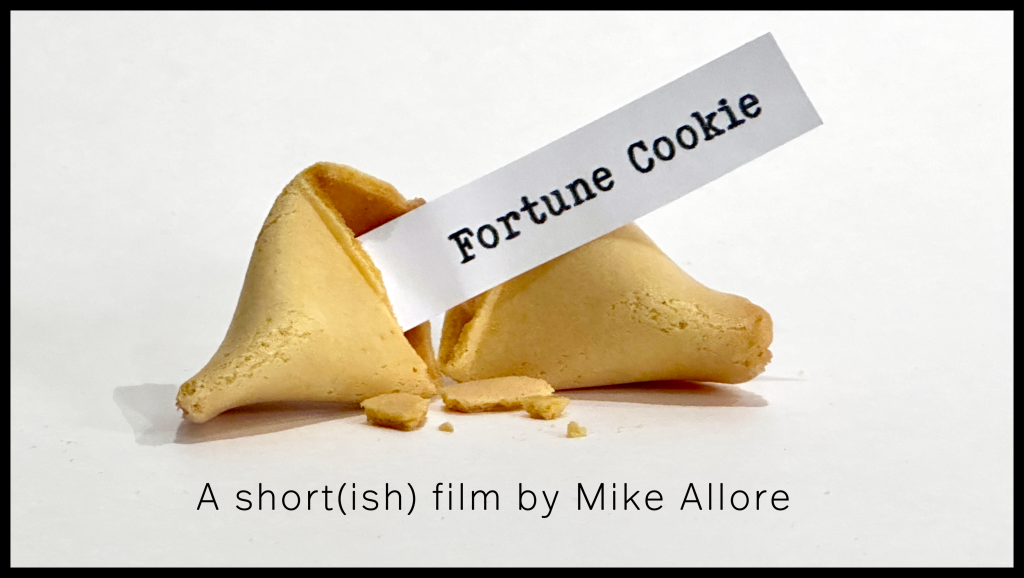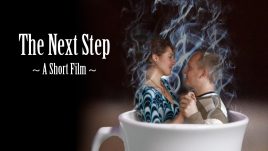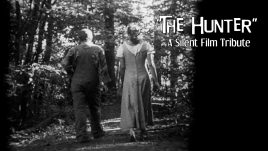David is having some trouble with the universe, seemingly set off by a random fortune cookie. In an attempt to bring balance back into his life, he reluctantly takes the advice of his girlfriend Diane to send some good into the world. Will it come back to David, or will the universe continue to mock him?

Fortune Cookie - Full Film
Idea & Pre-Production
John Lennon famously wrote, “Life is what happens to you while you’re busy making other plans.” In the time since I completed “The Hunter,” I worked at a video rental store, was hired as an assistant to the Senior Producer/Director at the General Motors media group, which led to a job at Henry Ford Health System doing media production. I met my wife, got married, went to school to get my teaching certificate, along with a Career and Technical Education endorsement. After five years of doing production work at Henry Ford, I was hired into Utica Community Schools to teach filmmaking and digital arts. My son Jack was born in 2005. Independent film production didn’t fit into life’s plan during that time.
Under the teacher contract, taking my eduction to a Masters degree would provide a good increase in pay. It would also be a chance to create some short films again by getting a Masters degree in Media Arts with a production emphasis at Wayne State University in Detroit. So I jumped back into filmmaking in the midst of a young family and teaching full time.
For my first production class, I started reading independent short fiction stories on the web looking for a story to adapt. After creating “The Hunter” as a modern silent film, I was ready to embark into the world of talkies. Shooting dialogue was something I wanted more experience with, so I was specifically looking for a story that was dialogue driven. The one that caught my attention was “Fortune Cookie” by James Swingle. It was a single scene in a restaurant, and the progression of the dialogue had it’s own unique cadence. The themes of the universe having a role on what comes back to a person in life was something I always wanted to explore in a film as well. I contacted James to ask permission to create a short film of his story, and expand on the characters’ stories. I was excited that he agreed, so I started work on the screenplay.
One person that was on my mind was former Negro League Baseball player Buck O’Neil. He had recently passed away, and he was one of my “Mount Rushmore of Kindness” inspirations, which also had Jim Henson, Fred Rogers and Ernie Harwell. The Christmas before I was looking at the newspaper and saw a notice that Buck was going to be at a local mall doing a meet and greet in January. I had always wanted to meet Buck. I made sure to go. He was sitting with a couple people in an open area of the mall as people walked to the surrounding stores. It astounded me that not many people were there to see him. I got a couple autographs, one on a photo of him while he was on the Kansas City Monarchs, and had a picture taken with him. (The person who took it never had a photo composition class, demonstrated by the amount of headroom he had in the photo, so some cropping had to be done)
With only a couple people around him, it was more of a casual hang out together rather than getting an autograph, a photo, and moving on. I never thought I would get a chance to just chat with Buck. I asked him about the frustration that must have been with not being allowed to play in the MLB. He responded that there was probably some, but if he spent that time being frustrated with that, he would have missed the fun that was there right in front of him. That’s where life happens. I found that Buck’s perspective was a force built on 94 years of life. I could see his focus was not dwelling on the past, but still appreciating what was there before him, and still ahead of him. He enjoyed meeting people and learning about them. I left feeling renewed.
It was just a couple months later that Buck missed being inducted to the Baseball Hall of Fame in Cooperstown by a single vote. Many of his peers were inducted. I couldn’t believe it. I read the Buck was most certainly disappointed, but his response was, “That’s the way the cookie crumbles.” The amount of people who were outright upset over this snub was very large. And I was one of them. He had great numbers as a player, and the best as an ambassador. It became a driving force of the screenplay. It would be easy to think that if good things don’t come back to one of the kindest, most beautiful humans like Buck, it just doesn’t happen at all. It’s much more complex than that.
Once I had a pretty solid draft of the script, I held my own casting call. I was aware that the casting process through Wayne State University was a process where actors came to the school and read for the different productions that were being made that semester. Filmmakers would put who their first, second, and possibly third choices for the roles being offered. The staff at Wayne State would then divide up the cast between the productions. I didn’t want to lose the ability to decide collaboratively with an actor on the casting.
At my casting call, I met so many great local actors, including Patrick Michael Kenny and Charlyn Swarthout. I knew they were both perfect for the roles of David and Rebecca. They were also a couple, so they already had a working chemistry together too. For the role of Diana, a fellow Wayne State student highly recommended Kira Frabotta for the role. I contacted Kira, and she accepted the role. I couldn’t have been happier or more excited about the casting of the three main roles. They also attended the Wayne State auditions, and afterwards I was given my casting sheet from the department, which didn’t include two of the three. But because I had done my own casting call, and met them there first, I didn’t need to follow the department’s casting choices.
The role of Stella Minor Brown was crucial to the story, and finding an older Black actress was proving to be a challenge. I checked with theater groups, and wasn’t getting much response. While checking with the Older Person’s Commission in Rochester for extras to be in some of the scenes at the assisted living center, I put in contact with Lillie Fuller. She wasn’t an actress, but was excited about giving it a shot. Something different from her work in real estate. I met Lillie at her house, and she had so much warmth and kindness. She was also pretty nervous about actually acting even though she wanted to do it. I told Lillie I believed in her, and we would work with her. I gave her a script, and one that just had pages with her scenes/lines.
Because I had no choice but to shoot this on dreaded video, I knew I wanted some more advanced camera movement to offset the camcorder look. I purchased a book on building camera rigs, which included a crane. My best friend, Rob Newman, who had also rebuilt the treehouse for “The Hunter,” worked with metal a lot. I gave him a solid tripod base, and he welded together a crane for me. It was a bit cumbersome to set up, but it provided wonderful cinematic movements in the shots I needed it for.
Aside from casting, the biggest challenge from the screenplay was going to be locations. I needed real environments, and it was going to be significantly more difficult to arrange than just finding areas in the woods like I did with the hunter. I was going to need permission from multiple places, including an assisted living home, a restaurant, business offices, a parking structure, and a bar. Every environment to me is a character. I love working within a good visual location, even if it takes a lot of effort to secure the location, get there, and film in it.
A student of mine worked at a restaurant called the Hong Kong Cafe, and the manager had done some acting before. I was able to secure the restaurant for a Sunday morning before they opened at 1pm. Char had to leave by noon to get to another rehearsal because she was starring in Jeff Daniels’ play “Escanaba in Love,” a prequel to his hit “Escanaba in da Moonlight.” I had limited time before real customers came in, which was a bit stressful. Between a mixture of local actors willing to help out and students, I was able to fill the restaurant with extras and two options of food for them. I had students assisting me as crew. Gary Bosek, a talented filmmaker and actor, was assisting with crew and acting on screen.
Production
Patrick and Charlyn were fully prepared and made filming the long dialogue sequence a breeze. (Other than a student turning on a Lowell Tota light without opening the barn doors and melting the metal casing of the light) We were able to get all the footage we needed with dialogue in time for Char to leave for her rehearsal and before the restaurant opened, But we still needed to get the last few shots of Patrick while the restaurant opened, finally getting the equipment out of the restaurant as customers at their lunch.
The following Saturday we filmed our first scene at Sunrise Senior Living. It was meaningful to me because my Grandma (Maxine), and her older sister (my Aunt Bea), were both extras playing cards at the table. I still miss them both, so I love seeing them in that scene. Lille ultimately did a fantastic job with her first acting assignment. It took some time and some coaching because she hadn’t memorized her lines, but when she put on her charisma, it really showed up! I had to spend a lot of time mentally editing her lines in my head when we would get those takes, so I could assemble the best lines when cutting them together. I still hear people say how much they love her performance, and that makes me incredibly happy. Lillie was so gentle and kind, I couldn’t imagine anyone else playing Stella Minor Brown.
One location that I don’t even recall how I was able to secure, was the parking structure. It was in Birmingham, Michigan, and I’m guessing I received permission from the city, but I can’t say for sure! I do know that I was trying to figure out how to get the close-ups of both Patrick and Kira as they were driving through the garage. I originally tried actually sitting on the hood of the Blazer as Patrick (very) slowly let the car move. It looked terrible. Nothing seemed to work. Thankfully, the scene took place at night, and we had a few lights with us. I backed the Blazer into a spot near an outlet. I sat on the hood with the camera, and slightly moved it to give a sense of the car moving. But what really sold it was that I had a student take one of the lights and pan it across the windshield on a regular pattern. With some sound effects of the car engine, it worked perfectly.
When we filmed in the bar, the scene required Charlyn to fall off a table. I knew that I didn’t want to film it in a “student film” way by showing her start to lose her balance, cut to a reaction shot in the room with crashing sound effects, then seeing her on the floor. I was ok with her falling out of the frame, but I wanted it to show her legitimately falling. I looked in the Michigan Production Guide for anyone that might know film stunts. Surprisingly, I found someone the lived right in the area. His name was Bob Marrocco, and he had done stunt work for Titanic, Cast Away, and Poseidon. I called Bob, not knowing what to expect, and he was the friendliest, and most motivated person I had met! He was excited to help out a “no-budget” filmmaker like myself. He met me in my classroom during my prep-hour, and planned the shot out. On the actual day of filming, he brought his stunt pads and cushions. In the script, Char was supposed to be standing on the table, but because the bar had a lower ceiling, she had to crawl on top of the table and stay on her hands and knees. It actually worked out better that way, because when she went to reach forward, that forward momentum naturally brought her off the table. When she fell, her body twisted in a way that looked like a drop straight to the ground! The cushion Bob brought was hidden by the table in foreground of the shot, and the results looked authentic.
Post Production
I was editing scenes together as we would film them, but once filming wrapped, I was editing around work and family. I wanted more experience in editing dialogue, and I was getting that in droves on this film. I also over-shot my 22-25 minute mark on this film by almost double, with a final run time of 45 minutes. That concerned me. It wasn’t a short film anymore, but it wasn’t a feature. But it was the film I made.
I used Garage Band music loops to create most of the musical themes in the film. At the same time, Augie Visocchi of the Detroit music group The Hard Lessons was student teaching at my school. I went through their albums and got permission from him to use a couple of their songs in the film. I also got permission from the management of Guy Davis to use his song “We All Need Some Kindness in this World” for the end credits.
By the time “Fortune Cookie” was finished for the WSU film showcase, I felt it was a good film, but I had some of my own criticisms regarding structure and pacing. Once I saw it together, I loved the performances of the actors in the film, and I thought professionalism in it was there. But I felt like I had not lived up to my own expectations on my end. I was excited to get some feedback with the showing. The showcase was divided into two parts, with an intermission between the two halves. It was held at an off-campus location in Detroit, and the turnout was really good. “Fortune Cookie” was scheduled to start the second half right after intermission. Unfortunately, most people that came to the showing only stayed for the first half. So not many people were able to provide feedback, because they weren’t there.
Over time, “Fortune Cookie” got hidden away, and I chalked it up as a learning experience. Then, in 2024, I saw the file on a drive, and decided to watch it. Some of my criticisms were valid, but not to the level I remembered from years ago. I felt with some re-cutting and reorganizing, I could fix the structure issue and some of the pacing issues I had with it. Now, after almost 18 years, I can say this is a film that shows someone still learning, but it’s a good little film with some Frank Capra inspiration.









